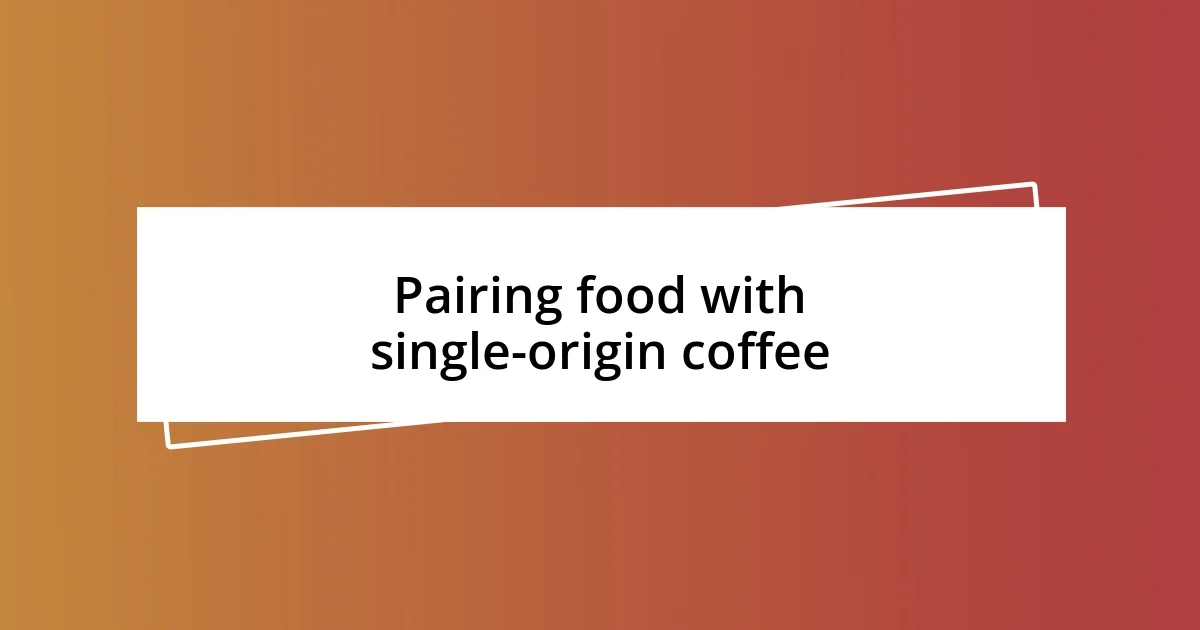Key takeaways:
- Single-origin coffees offer distinct flavor profiles influenced by their specific regions, allowing consumers to connect culturally and personally with the coffee’s origins.
- Sourcing single-origin coffee supports sustainable practices, fair trade, and local economies, enhancing appreciation for the craft and the farmers behind the beans.
- Brewing methods significantly affect the taste experience, and pairing single-origin coffee with complementary foods can elevate both the coffee and the dining experience.

Understanding single-origin coffees
Single-origin coffees come from a specific region, country, or even a single farm, and this distinct origin impacts the flavor profile dramatically. I remember the first time I sipped a truly single-origin brew—it was like getting a glimpse into the landscape of the farm where it was grown. Have you ever thought about how the altitude, soil, and climate can transform a humble bean into a vibrant experience?
These coffees exhibit unique characteristics that tell a story about their environment. For instance, I once tried a Kenyan coffee that was bright and fruity, packed with berry notes that literally danced on my palate. It sparked a curiosity in me—how much of this flavor can be attributed to the specific cultivation practices employed by the farmers?
Exploring single-origin coffees is an invitation to taste the world, one sip at a time. Each cup becomes a personal connection to the farmers and regions behind the beans. Have you ever paused to think about the journey that coffee takes before it reaches your mug? It’s fascinating how a simple drink can carry such rich histories and emotions.

Importance of sourcing single-origin coffee
Sourcing single-origin coffee holds immense importance not only for flavor but also for ethical connections. Personally, I find that each time I choose a single-origin brew, I’m not just indulging in a beverage; I’m also supporting sustainable practices and fair trade initiatives. The story behind each origin can inspire a deeper appreciation for the craft and the farmers who dedicate their lives to harvesting these unique beans.
- Flavor profiles: Single-origin coffees showcase distinct flavors shaped by their specific regions, allowing you to explore diverse tastes.
- Cultural connection: Sourcing from a single origin connects you to the culture and traditions of the coffee-growing community.
- Economic impact: Choosing single-origin coffee contributes to supporting local economies and provides fair compensation to farmers.
- Sustainability: Opting for these coffees often promotes environmentally friendly farming practices, benefiting both the planet and the farmers.
I vividly recall my trip to a small coffee farm in Colombia, where I met the farmer. He passionately shared how the shade of the overhanging trees affected the coffee’s sweetness. It was eye-opening. That moment not only deepened my love for coffee but also made me realize how important it is to support the places where our favorite beverages originate. It’s a beautiful reminder of how interconnected we all are.

Brewing methods for single-origin coffee
Brewing single-origin coffee is an art that can highlight the unique characteristics of the beans. When I first experimented with a pour-over method using my favorite Ethiopian Yirgacheffe, the flavors blossomed in a way that truly captivated me. The gentle extraction allowed the floral notes to shine through, offering a sensory experience that was simply unforgettable. Have you ever tried brewing your coffee with different methods to see how it changes the taste?
Then there’s the French press, which I love for its rich, full-bodied outcome. I remember a chilly morning when I decided to brew a Guatemalan coffee this way. The result was a robust, smooth cup that wrapped me in warmth, echoing the comforts of home. Each brewing method brings out different elements from the beans, making it exciting to explore what suits your taste.
Here’s a little comparison of brewing methods for single-origin coffee. You might find it helpful when choosing how to prepare your next cup!
| Brewing Method | Flavor Profile |
|---|---|
| Pour-Over | Bright and floral, highlighting intricate flavors |
| French Press | Rich and full-bodied, with deeper notes |
| Aeropress | Clean and smooth, often with a balance of boldness |
| Espresso | Concentrated and intense, accentuating sweetness |

Tasting notes of single-origin coffees
The tasting notes of single-origin coffees can be remarkably nuanced, often reflecting the very environment in which they are grown. I remember sipping a Costa Rican coffee that was bright with citrus, making my taste buds dance with its lively acidity. Each sip took me back to the sun-drenched hillsides where the beans thrived, and I couldn’t help but marvel at how geography can shape flavor. What stories do you think these flavors tell?
Another memorable experience was with a bold Sumatra coffee, known for its earthy and herbal notes. I was taken aback by its deep body and low acidity, which wrapped around my palate like a warm hug on a rainy day. It left me pondering how the wet-hulling process contributes to that rich profile, further connecting me to its origin. Have you ever thought about how a coffee’s preparation affects its tasting notes?
Enjoying single-origin coffees is almost like traveling through a tapestry of flavors. For instance, the berry and stone fruit notes of an African coffee can transport you to an entirely different world. I still recall the delicate sweetness of a Rwandan brew that lingered pleasantly after each sip, compelling me to take another. It really made me appreciate how each cup tells its own fascinating tale. What flavors resonate with you the most?

Pairing food with single-origin coffee
Pairing food with single-origin coffee can elevate both the dining and coffee experience dramatically. I remember savoring a bright Kenyan coffee alongside some freshly baked lemon bars. The citrusy notes in both the coffee and dessert created an explosion of flavor that played harmoniously together, making that moment feel like a small celebration. Have you tried finding complimentary pairings that enhance your coffee experience?
Thinking a bit deeper, I’ve found that the earthy flavors of a Sumatran coffee shine when paired with dark chocolate. I recall an evening of indulgence, sitting with a rich, velvety chocolate dessert while sipping this bold brew. The combination was exquisite; the coffee’s low acidity and the chocolate’s sweetness intertwined perfectly, creating a balanced flavor profile. How have your experiences influenced your choice of food with your coffee?
Another delightful pairing that stands out to me is the combination of a floral Ethiopian coffee with a light, nutty cuisine, like hummus or roasted almonds. The subtle flavors of the coffee complemented the food beautifully, enhancing the overall freshness of both. It reminded me how the right pairing can bring out the best in each element. What are some unique pairings you’ve discovered that surprised you?

Sustainable practices in coffee sourcing
Sustainable practices in coffee sourcing have become increasingly important to me as I’ve explored the world of single-origin coffees. I vividly remember my visit to a small farm in Colombia, where the farmer explained how he implemented shade-grown techniques to protect the delicate ecosystem surrounding his coffee plants. Not only did this promote biodiversity, but it also resulted in beans with a distinctive flavor profile. Have you ever thought about how the environment impacts what ends up in your cup?
As I learned more, I was struck by the significance of fair trade practices. This concept resonated with me deeply during a conversation with a coffee grower, who shared how fair pricing enables him to invest in his community and improve living conditions for his workers. It reminded me that each cup of coffee can be a direct link to social upliftment. Have you considered the broader implications of the coffee you choose?
Another eye-opening moment came when I discovered the concept of direct trade, which cuts out middlemen and allows farmers to receive a larger portion of the profits. I still reflect on the connection I felt as I sipped a delicious Guatemalan brew, knowing that the farmer was well-compensated for his hard work. It highlighted a powerful truth for me: choosing sustainably sourced coffee can truly make a difference. Isn’t it amazing to think that our coffee choices can support both the environment and the communities that produce it?














